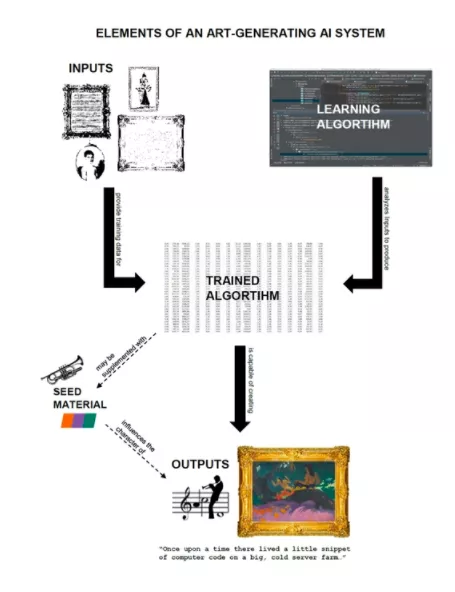
A Legal Anatomy of AI-generated Art: Part I
This Comment by Jessica Fjeld and Mason Kortz originally published in the Journal of Law and Technology's online Digest, is the first in a two-part series on how lawyers should think about art generated by artificial intelligences, particularly with regard to copyright law. This first part charts the anatomy of the AI-assisted artistic process. The second Comment in the series examine how copyright interests in these elements interact and provide practice tips for lawyers drafting license agreements or involved in disputes around AI-generated artwork.
Advanced algorithms that display cognition-like processes, popularly called artificial intelligences or “AIs,” are capable of generating sophisticated and provocative works of art.[1] These technologies differ from widely-used digital creation and editing tools in that they are capable of developing complex decision-making processes, leading to unexpected outcomes. Generative AI systems and the artwork they produce raise mind-bending questions of ownership, from broad policy concerns[2] to the individual interests of the artists, engineers, and researchers undertaking this work. Attorneys, too, are beginning to get involved, called on by their clients to draft licenses or manage disputes.
The Harvard Law School Cyberlaw Clinic at the Berkman Klein Center for Internet & Society has recently developed a practice in advising clients in the emerging field at the intersection of art and AI. We have seen for ourselves how attempts to negotiate licenses or settle disputes without a common understanding of the systems involved may result in vague and poorly understood agreements, and worse, unnecessary conflict between parties. More often than not, this friction arises between reasonable parties who are open to compromise, but suffer from a lack of clarity over what, exactly, is being negotiated. In the course of solving such problems, we have dissected generative AIs and studied their elements from a legal perspective. The result is an anatomy that forms the foundation of our thinking—and our practice—on the subject of AI-generated art. When the parties to an agreement or dispute share a common vocabulary and understanding of the nature of the work, many areas of potential conflict evaporate.